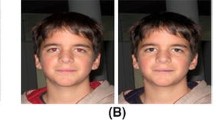Abstract
Color is a subjective term that changes according to each person’s view. We should define color physically to work with it in terms of printing or any other professional study. However, enabling the observation of color in terms of sales, marketing, product design, and development is as important as product and its packaging. The perception of color and tendencies to colors will be different for people of different eye colors. In this study, different color samples will be shown to five different eye colors of hazel, green, blue, brown, and black eyes both of men and women. The aim of the study is to determine which eye color is more perceived and adopted by which eye color using artificial neural network (ANN) for between 6 and 17 ages. By considering these determinations, it has been studied with graphical and statistical illustrations how different eye color groups prefer colors, how much they are able to recognize primary and secondary colors, and to what extent various eye colors are able to perceive RGB and CMY colors correctly.








Similar content being viewed by others
References
Battiti R (1992) First and second order methods for learning: between steepest descent and Newton’s method. Neural Comput 4(2):141–166
Bechtler H, Browne MW, Bansal PK, Kecman V (2001) New approach to dynamic modeling of vapour-compression liquid chillers: artificial neural networks. Appl Therm Eng 21(9):941–953
Chouai A, Laugier S, Richon D (2002) Modeling of thermodynamic properties using neural networks: application to refrigerants. Fluid Phase Equilib 199(1–2):53–62
Color Tune 3.0 Macintosh User’s Guide (1997) Agfa-Gevaert
Color ICC Output Profiles for Production Process and Proofing Devices (1999) IFRA
Color and Color Management (1999) X-rite, Technical bulletin, The Secrets of Color Management. Agfa-Gevaert, Belgium
Hagan M, Menhaj M (1994) Training feed-forward networks with the Marquardt algorithm. IEEE Trans Neural Netw 5(6):989–993
Kalogirou SA (2001) Applications of artificial neural-networks for energy systems. Appl Energy 67(1–2):17–35
Karataş C, Sozen A, Arcaklıog˘lu E, Ergüney S (2007) Modelling of yield length in the mould of commercial plastics using artificial neural networks. Mater Des 28(1):278–286
Kose E, Selimbeyoğlu C (2006) Color perception of men in different age groups. Karaelmas University, Karabük Technical Education Faculty. J Sci 9(3):171–179
Köse E, Şahinbaşkan T, Güler İ (2009) The investigation of effects of digital proofing systems used in color management on print quality with neural networks. Expert Syst Appl 36(1):745–754
Marquardt D (1963) An algorithm for least squares estimation of nonlinear parameters. J Soc Ind Appl Math 11(2):431–441
Mellit A, Benghanemb M, Kalogirou SA (2007) Modeling and simulation of a standalone photovoltaic system using an adaptive artificial neural network: Proposition for a new sizing procedure. J Int Renew Energy 32(2):285–313
Mohandes M, Rehman S, Halawani TO (1998) Estimation of global solar radiation using artificial neural networks. J Int Renew Energy 14(1–4):179–184
Palau A, Velo E, Puigjaner L (1999) Use of neural networks and expert systems to control a gas/solid sorption chilling machine. Int J Refrig 22(1):59–66
Reddy KS, Ranjan M (2003) Solar resource estimation using artificial neural networks and comparison with other correlation models. Energy Convers Manage 37(2):183–198
Selimbeyoğlu C, Ural ÖU, Sönmez S, Kurt B (2003) The perception of color to different age groups. In: 1st international printing technologies symposium, pp 412–424
Sozen A, Arcaklioglu E, Ozalp M (2004) Investigation of thermodynamic properties of refrigerant/absorbent couples using artificial neural networks. Chem Eng Process 43:1253–1264
Sozen A, Arcaklıog˘lu E, Özalp M, Kanıt EG (2004) Use of artificial neural networks for mapping the solar potential in Turkey. Appl Energy 77(3):273–286
Scanning for Color Management (2001) Hutcheson consulting, technical bulletin
Şahinbaşkan T, Selimbeyoğlu C (2000) Reproduction technologies class notes. Marmara University Faculty of Technical Education, Istanbul
Author information
Authors and Affiliations
Corresponding author
Rights and permissions
About this article
Cite this article
Cengiz, C., Köse, E. Modelling of color perception of different eye colors using artificial neural networks. Neural Comput & Applic 23, 2323–2332 (2013). https://doi.org/10.1007/s00521-012-1185-x
Received:
Accepted:
Published:
Issue Date:
DOI: https://doi.org/10.1007/s00521-012-1185-x




